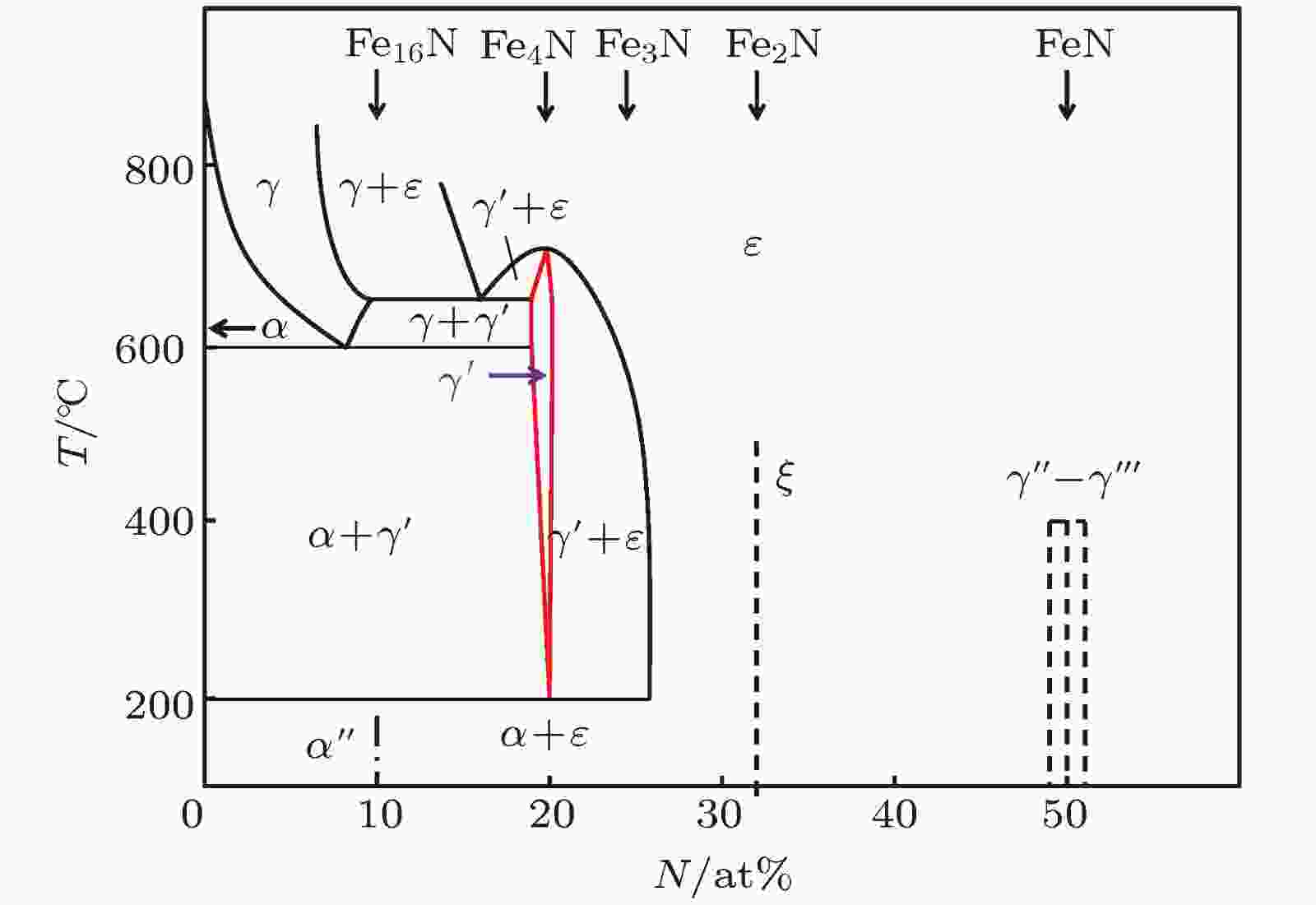全文HTML
--> --> -->吉林大学的Zheng等[18-20]较早对Fe-N体系薄膜材料进行了系统的研究, 他们主要利用反应溅射, 先是通过调节反应气体N2/Ar的比例获得了单相γ''-FeN薄膜, 以及ε-Fe3N和γ'-Fe4N, FeN和α''-Fe16N2等混合相的Fe-N薄膜; 后又通过控制基底温度、改变衬底类型等调控Fe-N薄膜的晶相. 其研究表明, 玻璃和单晶Si (100)衬底上沉积单相γ'-Fe4N薄膜的最佳温度都是250 ℃, 而单晶NaCl衬底上生长单相γ'-Fe4N薄膜的最佳温度为150 ℃. 这些温度比块体Fe-N退火得到γ'-Fe4N相的转化温度700 K (427 ℃)[21]要低很多, 说明Fe-N纳米薄膜的生长过程更易受到衬底表面性质和温度的影响. 另外, 他们还研究了Fe-N薄膜的磁学性能. 此后, 天津大学的Mi等[16,22-25]利用对靶磁控溅射技术在单晶γ'-Fe4N薄膜的合成方面取得了较大进展, 并着重研究了Fe-N薄膜的磁学和电学性能, 主要包括反常霍尔效应和磁电阻效应等, 为γ'-Fe4N等薄膜的应用奠定了基础.
根据Fe-N体系相图[26](如图1所示), Fe-N体系存在多种晶相, 而且多数晶相(包括γ'-Fe4N在内)属于亚稳相, 因此对其进行热稳定性的研究非常有必要. 德国的Widenmeyer等[27,28]对Fe-N体系进行了较系统的热分析研究. 他们分别选取ξ-Fe2N0.95, ε-Fe3N1.37和γ'-Fe4N的粉末样品进行热重 (TG)分析, 发现随着加热温度的上升, 三组样品Fe-N体系中的N含量都会持续减少, 直至温度达到约800 ℃后完全转化成α-Fe, 损失的质量全部归因于N的析出; 此外, ξ-Fe2N0.95 (10 ℃/min)和ε-Fe3N1.37 (1 ℃/min)的TG曲线中都出现了明显的台阶, 这被认为是中间相γ'-Fe4N产生的标志. 不过, 单一的TG曲线并不能反映晶相转变过程中通常伴存的相变潜热等现象, 也无法准确标识Fe-N体系发生相变的温度界限.
 图 1 Fe-N体系相图[24]
图 1 Fe-N体系相图[24]Figure1. Phase diagram of Fe-N system[24].
本文针对Fe-N体系薄膜材料, 主要开展了氮化铁的晶相合成、同步热分析和磁性等相关研究. 利用反应溅射制备了氮化铁薄膜材料, 然后通过真空磁退火调控氮化铁薄膜的晶相; 采用热重-差式扫描量热法 (TG-DSC)对氮化铁薄膜进行同步热分析, 准确标识氮化铁薄膜在加热过程中的晶相转变节点和关系到相变潜热的吸/放热峰, 探讨晶相转变过程中是否产生相变潜热的内在因素; 此外, 研究了氮化铁薄膜的面内/面外磁学特性.
原子力显微镜 (AFM)测量薄膜样品的表面形貌; X-射线衍射仪 (XRD)测量薄膜的X-射线衍射谱, 平行光模式, 入射角与样品薄膜平面之间的夹角 ≤ 5°; TG-DSC测量样品的TG-DSC曲线, 升温速率10 ℃/min, 测试范围常温(RT)至800 ℃, 保护气体Ar; 振动样品磁强计(VSM)测量样品的面内/面外磁滞回线.
 图 2 溅射得到的氮化铁薄膜的AFM图谱
图 2 溅射得到的氮化铁薄膜的AFM图谱Figure2. AFM spectrum of the iron nitride film obtained by sputtering.
氮化铁薄膜经不同温度退火2 h前后的XRD图谱如图3所示. 图3(a)中仅有一个衍射峰, 对应于立方相的γ''-FeN (JCPDS, No. 88-2153), 表明直接溅射得到的氮化铁薄膜是单相的γ''-FeN. 经250 ℃退火2 h后, 样品的晶相保持不变, 但半峰宽变窄, 表明样品结晶性变好. 当退火温度提高到350 ℃时, 衍射峰位置和相对强度都发生了明显改变, 对应于六角相ξ-Fe2N (JCPDS, No. 89-3939), 表明样品的晶相已经完全转变成单相的ξ-Fe2N. 继续升高退火温度到380 ℃时, 样品的衍射峰表现出整体向右平移, 对应于六角相的ε-Fe3N (JCPDS, No. 83-0876), 此时样品的晶相完全由ε-Fe3N构成. 当退火温度继续升高到400 ℃时, 衍射峰的位置继续右移, 原对应于ε-Fe3N (JCPDS, No. 83-0876)的衍射峰变成对应于ε-Fe3N (JCPDS, No. 83-0879). 因为ε-Fe3N相实际上应该写成ε-Fe3–xN (0 ≤ x < 1), 根据x (N含量)不同, ε-Fe3–xN相衍射峰的位置不同, 而且衍射峰右移表明样品中的N含量在减少. 此外, 400 ℃退火的样品在41.2°附近出现了新的衍射峰, 对应于立方相的γ'-Fe4N (JCPDS, No. 83-0875), 表明此时样品中的Fe/N (原子比)已经大于3/1. 进一步提高退火温度到450 ℃时, 对应于γ'-Fe4N相的衍射峰的相对强度明显增强, 其最强峰(111)与对应于ε-Fe3N相的最强峰(111)的峰强几乎相等, 表明样品中γ'-Fe4N相和ε-Fe3N相的比例已经接近1∶1.
 图 3 不同温度退火2 h前后的氮化铁薄膜的XRD图谱
图 3 不同温度退火2 h前后的氮化铁薄膜的XRD图谱Figure3. XRD patterns of iron nitride films before and after annealing at different temperatures for 2 hours.
根据文献[21]报道, Fe-N转变成γ'-Fe4N的温度是427 ℃, 然而我们对γ''-FeN相的氮化铁薄膜在450 ℃退火2 h得到的样品却是γ'-Fe4N和ε-Fe3N的混合相, 其Fe∶N (原子比)显然小于4∶1. 为了获得单相的γ'-Fe4N薄膜, 我们不得不考虑延长退火时间, 而退火温度就选择比文献报道略高的430 ℃. γ'-FeN薄膜在430 ℃退火不同时间的XRD图谱如图4所示(注: 该图的数据与我们前期发表的文章[29]的Fig.3(c)相同). 当430 ℃退火时间为0 h (保温时间 < 1 min), 所有的衍射峰都对应于ε-Fe3N (JCPDS, No. 73-2101), 是单相的ε-Fe3N; 延长退火时间至3 h, 样品为ε-Fe3N和γ'-Fe4N的混合相; 进一步延长退火时间到7 h, ε-Fe3N相已完全消失, 只留下γ'-Fe4N相, 表明γ''-FeN薄膜经430 ℃退火7 h可以完全转变成单相的γ'-Fe4N, 符合实验预期; 同时也说明γ'-Fe4N在Fe-N体系多种亚稳相中是相对比较稳定的, 其居里温度高达767 K[30].
 图 4 430 ℃退火不同时间的氮化铁薄膜的XRD图谱[29]
图 4 430 ℃退火不同时间的氮化铁薄膜的XRD图谱[29]Figure4. XRD pattern of iron nitride films with different annealing time at 430 ℃[29].
根据XRD的结果, 对于氮化铁(γ''-FeN)薄膜, 随着退火温度的升高, Fe-N体系中的N含量将持续减少, 并且这种组分的变化导致了晶相的改变, 其晶相转变的方向是γ''-FeN→ξ-Fe2N→ε-Fe3N→γ'-Fe4N, 这符合Fe-N体系相图[24], 也与Widenmeyer等[27]热分析的结果基本一致. 为了进一步明确退火诱导Fe-N体系晶相合成的机制, 把溅射得到的约180 nm厚的γ''-FeN薄膜从硅基底上剥离下来, 并进行了TG-DSC同步热分析(升温速率10 ℃/min, Ar气氛), 结果如图5所示. 在330 ℃之前, TG曲线(粗实线)处于平台期, 质量仅缓慢减少了1.36%, 还不足以引起γ''-FeN薄膜晶相的改变. 从330 ℃开始至690 ℃为止, TG曲线中出现了5级较明显的台阶, 反映在其一阶导数, 即DTG曲线(虚线)上就是5个波谷: I (330—415 ℃), II (415—490 ℃), III (510—562 ℃), IV (590—636 ℃), V (636—690 ℃), 表明样品经历了5次晶相转变(相变)过程. 在690 ℃之后, TG曲线再次处于平台期, 质量不再减少, 表明样品中的N已经完全析出, 仅剩下熔沸点较高的Fe. 根据文献[27], 对于Fe-N体系, 样品在低于800 ℃的加热过程中, 其所有质量的减少都来源于N的析出: Fe-N→Fe+N2 (气体). 值得注意的是, γ''-FeN薄膜中的N是在330 ℃以后才开始快速析出, 也就是说要想在有限的时间内通过对Fe-N体系进行热处理的方式得到低氮相的氮化铁薄膜材料, 如γ'-Fe4N薄膜(前期我们曾对Fe1.8N薄膜在375 ℃退火24 h得到了单相的γ'-Fe4N[29]), 那么退火温度应该高于330 ℃.
 图 5 氮化铁薄膜的TG-DSC曲线(虚线为DTG, 是TG的一阶导数)
图 5 氮化铁薄膜的TG-DSC曲线(虚线为DTG, 是TG的一阶导数)Figure5. TG-DSC curves of iron nitride film (dotted line is DTG, which is the first derivative of TG).
虽然TG (DTG)曲线显示样品在RT—800 ℃共经历了5次相变过程, 然而在DSC曲线(细实线)上却仅有4个波峰(或波谷), 分别对应于I, III, IV, V这4个相变过程, 其中I和V是吸热过程, III和IV是放热过程. 为了弄清相变过程II为何在DSC曲线上没有体现, 截取TG曲线中相变发生前后的关键节点, 分析统计样品的化学组分、主要晶相和晶型等要素, 列于表1中. 其中化学组分依据样品中Fe和N的质量分数来确定, 并以690 ℃时质量共减少的22.5%为N的总含量, 余下的77.5%为Fe的总含量为基准. 根据表1的结果, TG曲线中5级台阶代表的5个相变过程分别为:
| 温度/℃ | 化学组分 | 主要晶相 | 晶型 |
| 330 | FeN1.1 | γ''-FeN | 立方 |
| 415 | Fe2N1.3 | ξ-Fe2N | 六角 |
| 490 | Fe3N1.4 | ε-Fe3N | 六角 |
| 510 | Fe3N1.3 | ε-Fe3N | 六角 |
| 562 | Fe4N | γ'-Fe4N | 立方 (Fe构成面心立方, N位于体心) |
| 590 | Fe4N0.7 | γ'-Fe4N | 立方 |
| 636 | Fe4N0.37 | γ-Fe | 面心立方 |
| 690 | Fe | α-Fe | 体心立方 |
表1TG-DSC曲线关键节点处Fe-N的化学组分、主要晶相和晶型
Table1.Chemical composition, main crystal phase, and crystal form of the Fe-N at key nodes of the TG-DSC curve.
根据TG-DSC的结果, 在同样的升温速率和保护气体下, ξ-Fe2N1.3开始分解的温度(415 ℃)与文献[27]报道ξ-Fe2N0.95的分解温度(417 ℃)非常接近, 但是前者转变成γ'-Fe4N的温度(562 ℃)比后者(641 ℃)要低, 并且最后转变成α-Fe的温度(690 ℃)也比后者(750 ℃)要低, 说明纳米级的氮化铁薄膜比普通粉末样品析出N的速度更快, 将具有更低的晶相转变温度. 此外值得注意的是, 在562 ℃时, 样品中Fe/N (原子比)刚好达到4/1, 相比真空退火的结果(430 ℃, 7 h), 这个温度虽然要高一些, 但是花费的时间却要短很多(约54 min), 那么是否存在一种快速热退火的方式, 使得Fe-N薄膜在较短的时间内完全转化成γ'-Fe4N相, 这有待于进一步研究.
氮化铁薄膜的面内VSM图谱如图6所示. γ''-FeN (RT), γ''-FeN (250 ℃, 2 h)和ξ-Fe2N (350 ℃, 2 h)的磁滞回线几乎都是一条斜率很小的直线, 表明γ''-FeN和ξ-Fe2N都没有磁性. ε-Fe3N (380 ℃, 2 h), ε-Fe3N和γ'-Fe4N (400 ℃, 2 h), γ'-Fe4N和ε-Fe3N (450 ℃, 2 h)以及γ'-Fe4N (430 ℃, 7 h)的磁滞回线都是标准的铁磁性磁滞回线, 其中γ'-Fe4N的饱和磁化强度(Ms)最大, 约为950 emu/cm3, 矫顽力较小, 约为200 Oe. 此外, ε-Fe3N的矫顽力最大, 约为350 Oe, 但Ms较小, 约为460 emu/cm3.
 图 6 氮化铁薄膜的面内VSM图谱
图 6 氮化铁薄膜的面内VSM图谱Figure6. In-plane VSM pattern of iron nitride films.
磁各向异性是铁磁体的基本特征之一, 主要包括磁晶各向异性、磁形状各向异性和交换磁各向异性等. 磁晶各向异性是磁性单晶体所固有的属性, 以γ'-Fe4N为例, 其晶体结构是由Fe原子组成面心立方的晶格结构, N原子占据体心位置, 属于立方晶系, 因此理论上其易磁化轴通常为[100]方向, 但由于我们制备的Fe4N薄膜是多晶的(如图4(c)所示), 其面内并不存在明显的磁各向异性. 下面主要讨论γ'-Fe4N多晶薄膜的面内/面外磁各向异性. 图7为430 ℃退火7 h得到的γ'-Fe4N薄膜的面内/面外VSM图谱, 面内/面外磁滞回线表现出明显的磁各向异性, 在面外有较大的退磁场, 是难磁化轴, 而面内任意方向都是易磁化轴, 这种磁各向异性属于典型的磁形状各向异性. 值得注意的是, 面内和面外磁化曲线最终达到的饱和磁化强度完全相等, 表明厚度约为180 nm的γ'-Fe4N薄膜样品在垂直膜面的方向上也能被完全磁化. 若逐渐减少薄膜的厚度, 那么是否存在一个临界点, 使得γ'-Fe4N薄膜在临界点附近其面内/面外饱和磁化强度发生突变, 这有待于进一步研究.
 图 7 γ'-Fe4N薄膜的面内和面外VSM图谱
图 7 γ'-Fe4N薄膜的面内和面外VSM图谱Figure7. In-plane & out-of-plane VSM pattern of the γ'-Fe4N film
感谢厦门大学材料学院王来森老师的讨论.
